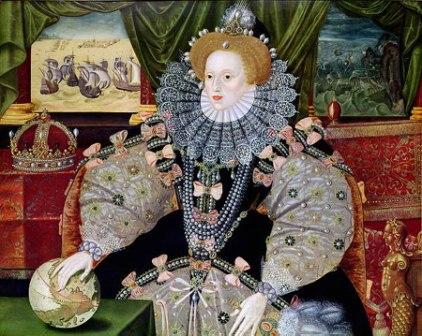 |
| The birth announcement of the Princess Elizabeth, 1533. Photo from Let Them Grumble on Tumblr. |
On this day in
Elizabethan history in 1533, the Princess Elizabeth Tudor was born at Greenwich Palace to King Henry VIII and Queen Anne Boleyn.
 |
| A detail of Anne's "H" & "A" intertwined initial pendant. From the Loseley House portrait. Image courtesy That Boleyn Girl on Flickr. |
Queen Anne had taken great care during her pregnancy to design nurseries in the
royal palaces for her child, among them Eltham Palace. On August 26th,
Anne had entered her confinement with her ladies to prepare for the birth of the royal baby. During this time, Henry VIII had consulted astrologers to determine the child's gender. Henry was delighted to "discover" that the child was to be a boy; but really, who would have dared to tell him otherwise? Henry VIII had birth announcements prematurely drawn up for a prince, but on
September 7th, two ss's
would have to be hastily tacked onto the word ‘prince’, as a daughter was
born.
The Princess Elizabeth was likely named for her two grandmothers, Elizabeth of York and
Elizabeth Howard. Henry was very disappointed, but he still had high hopes that he
and Anne would have sons, telling her,“You and I are both young, and by
God’s grace, boys will follow.”
The Princess
Elizabeth, who remarkably survived political danger and familial strife to
become arguably the most celebrated monarch in English history, was probably conceived
abroad in Calais, France. Calais had been an English territory since the medieval era
and was a popular place for English and French diplomacy to occur. In preparation for her marriage to King Henry, Anne Boleyn had been raised to the peerage in her own right as Marquess of Pembroke. King Henry wanted to
show off his future wife and Queen consort in a public relations trip abroad to rendezvous with his great foil, King Francis I.
 |
| A portrait of King Francis I. By Jean Clouet. Louvre Museum, Paris. |
Henry and Anne’s relationship had reached a dramatic turning point in Calais; after 7
long, exhausting years, evidence strongly suggests that the King of England and Anne finally sexually
consummated their relationship. In order for Anne to have
entered Henry’s bed after holding out for marriage and a crown for so long, it is likely that some simple marriage
ceremony must have been completed before the trip, or perhaps a pledging of their troth in the
presence of a witness. We know that Anne was referred to as “the king’s wife”
by foreigners in attendance at Calais, and that Henry and Anne’s apartments
had been connected by only one door.
Once Anne
had realized she was with child, it then became imperative for Henry VIII to
receive his divorce from his first wife, Catherine of Aragon, as soon as possible. The child in Anne's womb had to be legitimate. An official wedding was performed on January 25th
at York Place, later re-christened as Whitehall Palace. Since King Henry had
convinced himself that his first marriage was null and void, he did not believe
that he had committed bigamy by marrying Anne. But, in the eyes of the Roman Catholic Church, King Henry VIII was still legally
married to Catherine of Aragon. Henry awaited his
annulment, which was granted by Archbishop Thomas Cranmer on 23rd May,
1533; the Act of
Appeals formally separated England from Rome's authority, and Henry VIII's divorce
from Catherine of Aragon was granted under English law.
On September 10th,
the Princess Elizabeth was christened in grand finery at Greenwich, and though neither
parent was in attendance, this was the common royal practice, and was not, as some writers have surmised, an
indication of displeasure with the child’s gender.
Elizabeth Tudor was to spend a very brief time with her mother before Anne was executed in 1536. As was typical in 16th century royal
families, Elizabeth was to be breastfed by a wet-nurse, (despite Anne Boleyn's
protestations that she would breastfeed her daughter herself) and
infrequently saw her mother. Still, Anne Boleyn and Henry VIII visited their
daughter as often as their schedules would allow, and Anne kept up fervent
correspondence with those she had entrusted with Elizabeth's care.
 |
| Queen Elizabeth I, enthroned in the frontispiece of Saxton's Atlas. Attributed to Remegius Hogenberg, 1579. Picture acquired through Wikimedia Commons. Image public domain. |
I would like to personally wish a Happy 480th Birthday to
Queen Elizabeth I (1533-1603).
Elizabeth Tudor captured my heart long ago as a child, and she continues to inspire me on a daily basis, for which I am
eternally grateful.
I will continue to teach others about her and the importance of her legacy
for the rest of my life.
 |
| Ashlie as Queen Elizabeth I, greeting her loyal subjects. Picture by L.Jensen. Property of BeingBess. |
SEMPER EADEM.
 |
| Anne Boleyn's falcon badge, which was adopted by Queen Elizabeth I. For more on Queen Anne and Queen Elizabeth's shared heraldry, please read our article, "Death Could Not Separate Them: How Elizabeth I Connected to Her Deceased Mother". |

